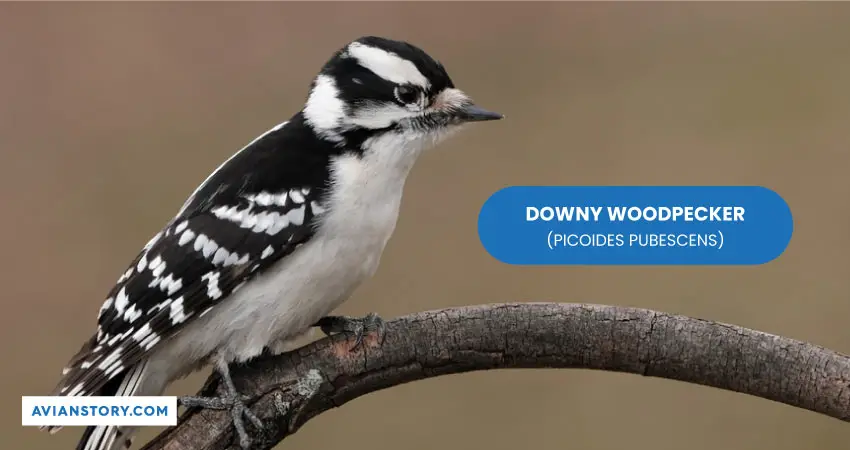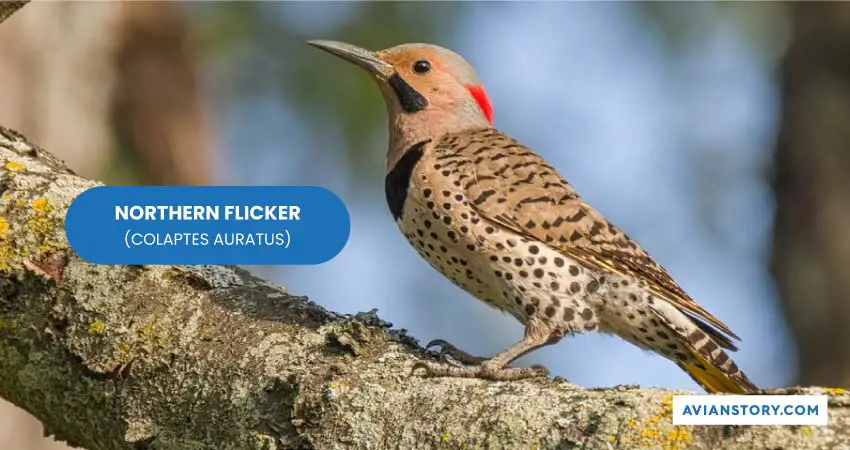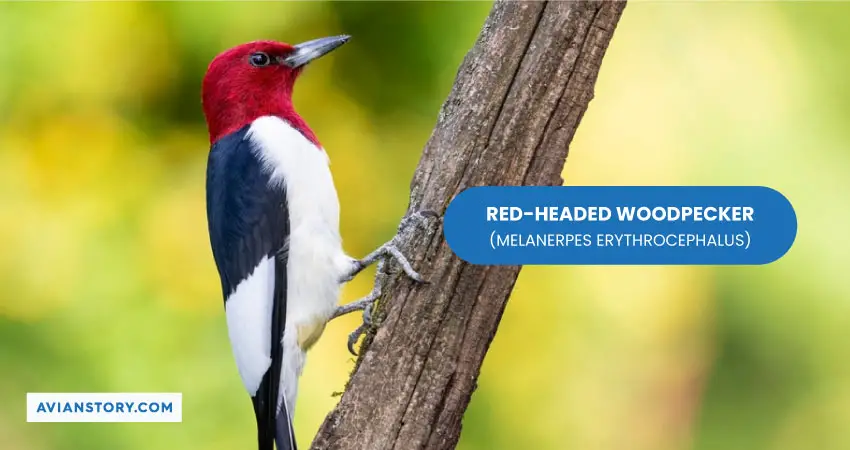Woodpeckers in Vermont: Varieties, Identification, and Lifestyle
With barbed tongues and fuzzy noses, the woodpeckers in Vermont can be seen drilling away at pine trees and oaks. Only in Vermont, you can find a motley crew of woodpeckers, often as many as ten!
Beech, birch, maple, and pine constitute 71% of Vermont’s forests, making this North American state a heaven on earth for different species of woodpeckers.
Woodpeckers belong to the bird family Picidae and are known for their unique appearance and habits. Keep reading to find interesting facts about the woodpeckers in VT.
| Species Name | Identifiable Feature | Length | Weight | Habitat |
| Pileated Woodpecker | A red crown | 16″-19″ | 9.8 | Heavily forested parks |
| Yellow-Bellied Sapsucker | Yellow underside | 7.5″- 8.5″ | 1.2- 2.2 oz. | Deciduous forests |
| Downy Woodpecker | Black and white stripes | 5.5″- 7.1″ | 0.71- 1.16 oz. | Second-growth forests and the suburbs |
| Northern Flicker | Orange feathers around the bill | 11″-12″ | 4.2 oz. | Open woodlots |
| Hairy Woodpecker | White, thread-like feathers near the tail | 9.8″ | 3.4 oz. | Conifer forests and swamps |
| American Three-toed Woodpecker | Yellow patch on the crest | 8.3″ | 1.9 oz. | Old growths and charred forests |
| Red-Headed Woodpecker | A completely redhead | 7.5″-9.8″ | 2- 3.4 oz. | Dead forests |
| Red-Bellied Sapsucker | Red breasts and a checkerboard body | 9″-10.5″ | 3.2 oz. | High-elevation deciduous forests |
| Black-Backed Woodpecker | Black upperparts and white underside | 9.1″ | 3.1 oz. | Young burned forests |
| Lewis’s Woodpecker | Pink belly and green wings | 10″-11″ | 3.2-4.9 oz. | Pine forests |
What Species of Woodpeckers to See in Vermont
Around 10 species of woodpeckers are found in Vermont, including the Pileated Woodpecker, Yellow-Bellied Sapsucker, Downy Woodpecker, Northern Flicker, Hairy Woodpecker, American Three-Toed Woodpecker, and more. Here you can learn how to ID these species and a bit about their lifestyle.
1. Pileated Woodpecker

- Scientific Name: Dryocopus pileatus
- Length: 16″- 19″
- Weight: 9.8 oz.
- Wingspan: up to 30″
- Lifespan: 12 years
The largest woodpecker in the world, the Pileated Woodpecker is a crow-sized bird with a red “mohawk” and a red mustache. The crimson crest of the Pileated Woodpecker makes it a well-loved species in the Green Mountain State.
It is mostly black in color and an intelligent insectivore. This species is also fond of blackberries, elderberries, and sumac berries and will seldom nibble at seeds from a backyard feeder.
Commonly Found In
Pileated Woodpeckers inhabit mature hardwood forests and heavily forested parks. These foliage-gleaning birds scour dead trees and stumps lying on the forest floor for food.
The Green Mountain National Forest or the Button Point Natural Area at the Button Bay State Park in Vermont have patches of old growth historically inhabited by Pileated Woodpeckers.
Fun Facts
- The Pileated Woodpecker is also known as “wood hen” and “carpenter bird.”
- They occasionally nest in the same tree hole for two successive years
- Pileated Woodpeckers are on the verge of extinction
2. Yellow-Bellied Sapsucker

- Scientific Name: Sphyrapicus varius
- Length: 7.5″- 8.5″
- Weight: 1.2- 2.2 oz.
- Wingspan: 13.5″- 15.7″
- Lifespan: 6 to 7 years
It is a medium-sized woodpecker with a bold face pattern. They have a pastel yellow belly that compliments the male bird’s red chin and crown. Females have a red crown, black chin, and a buff underside.
They have straight bills and a long, white patch at the base of their wings. In the wilderness, their dark backs allow them to camouflage on trees to stake out beetles and other arthropods.
Commonly Found In
These carpenter birds enjoy nectar, pine sap, tree nuts, and acorns. You might see them pecking at the wood in many of Vermont’s deciduous forests.
Yellow-Bellied Sapsuckers migrate to Canada for the mating season and then return to the arboraceous areas to the west of the Rocky Mountains. Look for neatly organized sap wells in tall trees whenever you visit the sapsuckers’ territory.
Fun Facts
- This is the only completely migratory woodpecker in eastern North America
- The Yellow-Bellied sapsucker breeds in the coastal areas of Canada
3. Downy Woodpecker

- Scientific Name: Picoides Pubescens
- Length: 5.5″- 7.1″
- Weight: 0.71- 1.16 oz.
- Wingspan: 9.8″- 12.2″
- Lifespan: 1- 2 years
Downy woodpeckers are the smallest woodpeckers in North America and can be seen year-round in Vermont. You can find a black back, a white underside, and alternating black and white stripes on the wings of them.
The name “Downy” comes from their silky soft plumage. A red dot sits at the back of the neck of a male woodpecker. Both males and females have smooth, rounded heads and don’t feature the head profile of their Pileated cousins.
Commonly Found In
Downy woodpeckers thrive in river groves, orchards, shade trees, and woodlots. They are known to live in a variety of landscapes, from second-growth forests to Vermont’s suburban yards.
Look for Downy Woodpeckers in the deciduous forests in Vermont, where they forage side by side with nuthatches and chickadees.
Fun Facts
- Downy Woodpeckers have special feathers near the nostrils that prevent them from inhaling wood chips.
- A male Downy can be quite the pinchpenny when it comes to sharing food with his female partner.
- The first mention of Downy Woodpeckers dates back to 1766 by Swedish biologist Carolus Linnaeus!
4. Northern Flicker

- Scientific Name: Colaptes auratus
- Length: 11″-12″
- Weight: 4.2 oz.
- Lifespan: 6 to 9 years maximum
The Northern Flicker has a characteristic black and brown speckled back, accompanied by a snowy rump patch that is visible in flight.
They have orange plumage that sits horizontally to their pointy bills and a black patch on the chest in the shape of a bow tie. Male Northern Flickers sport a distinctive black mustache.
Commonly Found In
Northern Flickers are frequently seen in the rural and urban areas of Vermont. They are no strangers to backyard feeders and love to snack on suet, seeds, and berries.
They are a common sight in Vermont’s open forests, groves, and woodlots, as well as cities where food and insects come by easily. And they prefer open spaces for foraging.
Cool Facts
- Northern Flickers engage in a “fencing duel” with rival males to attract the female bird.
- They like to forage with other birds on the ground.
5. Hairy Woodpecker

- Scientific Name: Leuconotopicus villosus
- Length: 9.8 inches
- Weight: 1.4- 3.4 oz.
- Wingspan: 15 inches
- Lifespan: 15 years maximum
The name Hairy Woodpecker comes from the hair-like white feathers that cascade down their black rears. They have an orange patch on the nape ending in a white stripe above each eye.
The Hairy Woodpecker and the Downy Woodpecker look similar, differing mostly in body shape and size of the bill. Leuconotopicus villosus is six and a half inches shorter than its Downy cousin. It has fully black feathers on its outer tail and wields a narrower bill.
Commonly Found In
The Hairy Woodpecker can be seen foraging in the juniper woodlands, groves, coniferous forests, and swamps in North America.
Some populations in the southwest inhabit open mountain forests and pine plantations. In Vermont, they spend their time scouring for ants, larvae, caterpillars, and wood-boring beetles and frequent the bird feeders for a taste of crumbly suet.
Fun Facts
- Hairy Woodpeckers have a naughty habit of following Pileated Woodpeckers. They secretly survey the tree holes the Pileated excavated and feed on leftover insects
- They sometimes drink sap from the wells made by sapsuckers in the trees
- The oldest Hairy Woodpecker recorded was at least 15 years and 11 months old when he was recaptured in New York in 2011.
6. American Three-toed Woodpecker

- Scientific Name: Picoides dorsalis
- Length: 8.3 inches
- Weight: 1.9 oz.
- Wingspan: 15 inches
- Lifespan: 6 years
American Three-Toed Woodpeckers have a distinctive smidge of yellow on their foreheads. Their tails and upper parts are mostly black, and the underside is a light shade of gray-white.
Black and white spots are sporadically painted on their wings. The specialty of having three toes allows them to bend farther away from trees and deliver powerful blows.
Their loss of the fourth toe is evolutionary and is a shared feature among two other species— the Black-Backed, and the Eurasian Three-toed.
Commonly Found In
Mature burned forests and old-growth patches are key areas to find the American Three-Toed Woodpecker.
The American Three-Toed occupies high-elevation spruce forests, such as the Montane Spruce-Fir Forest Area in Vermont. They also forage near boreal and conifer trees.
These birds have a habit of gleaning spruce bark beetles, which is a reason for populating Vermont’s spruce forests, and often its aspen, pine, tamarack, and willow.
Fun Facts
- American Three-toed and Eurasian Three-Toed are lookalikes, differing slightly in DNA sequence and voice.
- They are opportunistic feeders. During the Dutch Elm Disease outbreak in the 1970s, they traveled far from their usual range to feed on bark beetles.
7. Red-Headed Woodpecker

- Scientific Name: Melanerpes erythrocephalus
- Length: 7.5″- 9.8″
- Wingspan: 16.7 inches
- Weight: 2- 3.4 oz.
- Lifespan: 10-12 years
The Red-Headed Woodpecker is the most recognizable for its entirely scarlet head and white underside. Their wings are half black and half white, and the tail is inky black near the tip.
Red-Headed Woodpeckers catch their prey on the wing and are known to take several helpings of beech nuts and acorns. They are forward thinkers, saving extra food in small crevices for winter.
Commonly Found In
Look for this magnificent bird in Vermont’s open woodlots, dead forests, and pine savannas. Red-Headed Woodpeckers famously inhabit the agricultural areas in Vermont with a good supply of tree nuts and insects. Their flying from perch to perch, raucous call, and slow-tempo tapping give away their presence.
Cool Facts
- The Red-Headed Woodpecker is also called “jelly coat,” “half-shirt,” “shirt-tail bird,” and “flying checker-board.”
- According to ancient cultures, they symbolize good luck and spiritual healing.
8. Red-Bellied Sapsucker
- Scientific Name: Melanerpes carolinus
- Length: 9″- 10.5″
- Weight: 2.0- 3.2 oz.
- Wingspan: 15″- 18″
- Lifespan: 2- 3 years
Also known as Red-breasted sapsuckers, these birds are popular for their scarlet heads and checkerboard-patterned backs. They have red feathers around their chest that turn gray-white on the underside.
These woodpeckers are the size of a robin and like to forage for small insects in tree holes. Red-Bellied sapsuckers drill little crevices in trees from which they drink the flowing sap.
Commonly Found In
This species is commonly found in conifer forests and second-growth woodlands and forages in a variety of deciduous trees. During the winter season, they take shelter in densely wooded areas in the suburbs located in lower elevations.
Cool Facts
- Red-bellied Sapsuckers are social birds, living monogamously in large groups
- The incubation period of a Red-bellied Sapsucker is only 12 days!
9. Black-Backed Woodpecker

- Scientific Name: Picoides arcticus
- Length: 9.1 in/ 23 cm
- Weight: 2.1- 3.1 oz.
- Wingspan: 15.8″- 16.5″
- Lifespan: 6-8 years
The Black-backed woodpecker is pitch black above and snowy white below. Males sport a yellow crown and a white mustache. They have black and white barring on their flanks like many members of the woodpecker family.
Like the American Three-Toed, this woodpecker has three little toes on each foot. Despite their size, they are able to excavate harder wood, such as charred oak and lodgepole pine.
Commonly Found In
Black-backed Woodpeckers forage on the lower parts of trees, allowing local birdwatchers a comfortable view. They are found in young, burned growth no older than 8 years. They perch on thickly barked trees and stay busy all day gleaning juicy beetles.
Fun Facts
- Black-backed Woodpeckers are also called Arctic Three-Toed Woodpeckers
- Their old nests are often used by owls, chickadees, and nuthatches that cannot excavate on their own
10. Lewis’s Woodpecker

- Scientific Name: Melanerpes lewis
- Length: 10.”- 11″
- Weight: 3.1-4.9 oz.
- Wingspan: 19.3″- 20.5″
- Lifespan: 10 years (approx.)
Lewis’s Woodpecker has a pink and white gradient belly, accompanied by an emerald back and wings. They sport a gray collar and a flushed, red face. This species can fly like crows in fast wingbeats and are aerial foragers like flycatcher birds.
Like other birds in the Genus Picus, the Lewis’s Woodpecker does not drill into snags for wood-boring beetles. Instead, they feed on live insects caught on the wing. This behavior is called “flycatching,” which is characteristic of this flicker-sized woodpecker.
Commonly Found In
Lewis’s Woodpeckers can be found during their breeding season, which typically lasts from Late April to July. They inhabit the open woodlands and pine forests in large numbers in Vermont.
They often wander outside their pinewood habitats in search of tree nuts and acorns. Lewis’s woodpeckers also thrive in burned forests where they can peck at the soft snag and make little nests.
Fun Facts
- Lewis’s Woodpecker is named after Meriwether Lewis, an explorer who first discovered this unique species in America
- Baby woodpeckers do not have down feathers like songbirds when they hatch
Bottom Line
The open woodlots and pine forests of Vermont host a variety of woodpeckers throughout the seasons. Most woodpeckers in Vermont populate the State’s conifer trees, burned forests, and river groves.
Each has a distinctive call, style, and foraging habit that one can only know when they have done their homework. We hope this article helped you recognize many of Vermont’s woodpeckers off the bat!
Woodpeckers Found in Nearby States of Vermont:
